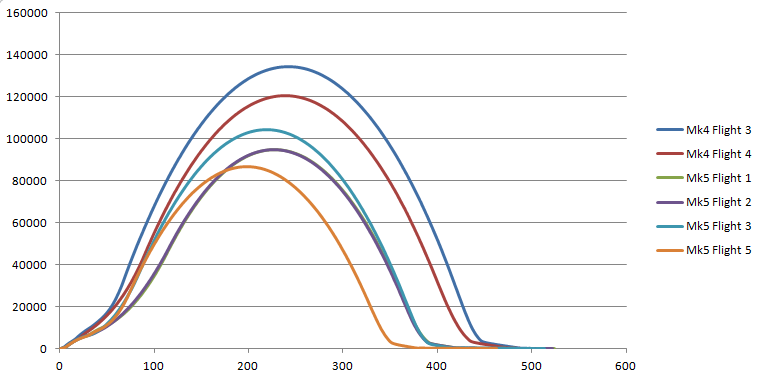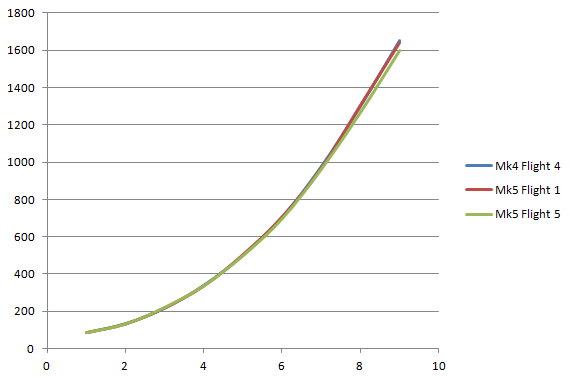 Progenitor teams have been spending the last few weeks pouring over data gathered from the flights of the Progeny Mk4 and Mk5 to see how they have compared in order to judge the overall performance of the new Mk5 after its initial series of 5 launches last month to develop & test our automated control software. The Mk5 sports the M-315 automated control unit and replaces the old control unit with an extra battery, which makes it only 36kg heavier than the Mk4 when both lack payload instruments. The inline control unit adds a bit of length to the third stage, with the Mk5 measuring in at 9.5m tall versus the Mk4’s 9.3m. The only other variation for the Mk5 was that we launched it at an initial pitch of 87° versus the Mk4 which was launched at 85°. While we expected most if not all of these launches to reach similar heights of the Mk4 or even exceed them, none actually did.
Progenitor teams have been spending the last few weeks pouring over data gathered from the flights of the Progeny Mk4 and Mk5 to see how they have compared in order to judge the overall performance of the new Mk5 after its initial series of 5 launches last month to develop & test our automated control software. The Mk5 sports the M-315 automated control unit and replaces the old control unit with an extra battery, which makes it only 36kg heavier than the Mk4 when both lack payload instruments. The inline control unit adds a bit of length to the third stage, with the Mk5 measuring in at 9.5m tall versus the Mk4’s 9.3m. The only other variation for the Mk5 was that we launched it at an initial pitch of 87° versus the Mk4 which was launched at 85°. While we expected most if not all of these launches to reach similar heights of the Mk4 or even exceed them, none actually did.
The two related reasons behind the inability of the Mk5 to surpass the Mk4 were initial pitch and coast duration between staging. Although the rocket launched at 87°, the initial drag at the nose pitched it up to as high as 89.4° within 1 second. Ascending so close to vertical gave the Mk5 a slower start due to having to fight gravity more, and it never caught up to the Mk4 in terms of ascent speed, even if we account for the Mk4’s slightly lesser mass. Since the rocket was standing up so straight, it also took a longer time to pitch over, which meant the coast periods were longer, during which the Mk5 lost more speed than it would gain back between the first and second stages compared to the Mk4. Let’s go to the graphs!
Detailed Technical Analysis
First let’s take a look at all the Progeny flights that have made it into space so far.
You’ll have to open the big version to see both the plots for Mk5 Flights 1 & 2 as they are practically on top of each other. It’s also important to note that the Mk4 Flight 3 was launched at 6Gs versus 4Gs for the rest of the flights and is included for comparison purposes in that regard only. You can already see the gap showing the performance difference in the initial ascents between the Mk4 and the Mk5. Here is a closer look:
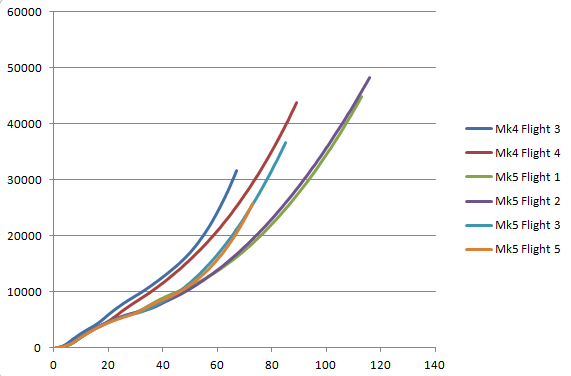
Altitude (ASL) in meters over time in seconds until the end of 3rd stage propulsion. Click for hi-res version
You can see that Mk5 Flights 3 & 5 started to catch up to the Mk4 during their 3rd stage burns pushing with a constant TWR of 3 (initially 80-90% throttle) but were never able to, even though the Mk4 was only throttled for a TWR of 2. The reason for this is shown in this next graph:
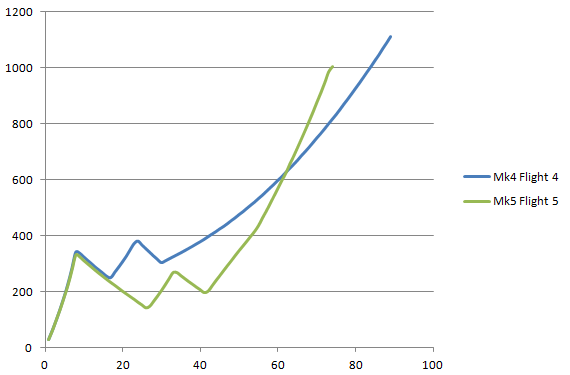
Surface velocity in m/s over time in seconds until the end of 3rd stage propulsion
Here is where the longer coast times to allow the nose to fall 1.5° really took its toll on the MK5. As you can see the Mk4 was able to regain all of the speed it lost during the first coast phase (and then some) whereas the Mk5 was not. The Mk5 in this flight was pushing with a TWR of 3 in the 3rd stage versus the MK4 pushing with a TWR of 2 so it accelerated faster towards the end but still did not achieve a velocity as high as the Mk4 nor an apokee as high, coming up 34km short.
Well, okay so we should have used shorter coast periods for launching more vertically, perhaps only 1° of pitch change or even 0.5°, but is there really any benefit to standing the rocket up so much? Let’s have a look at the initial boost off the pad, as that first stage is the most consistent performance phase across the Mk4 and Mk5 flights, affected only by mass:
You’ll want to view the hi-res version here for sure. The mass difference between the Mk4 and Mk5 Flight 1 (carrying no payload) was a mere 11kg whereas the weight difference between the Mk4 and Mk5 Flight 5 (carrying the heaviest payload) was 51kg. Even with almost comparable mass the performance gain was negligible between the MK4 and Mk5 Flight 1.
Pretty much the only benefit we can see to launching more vertically is that our recovery zone was only an average of 38km downrange for the Mk5 versus 134km for the Mk4. However since we have no restrictions as to the distance from which we can recover payloads downrange this benefit does nothing for us. All these considerations have been taken into account for the next iteration of the Mk5.
Progeny Mk5 Block I
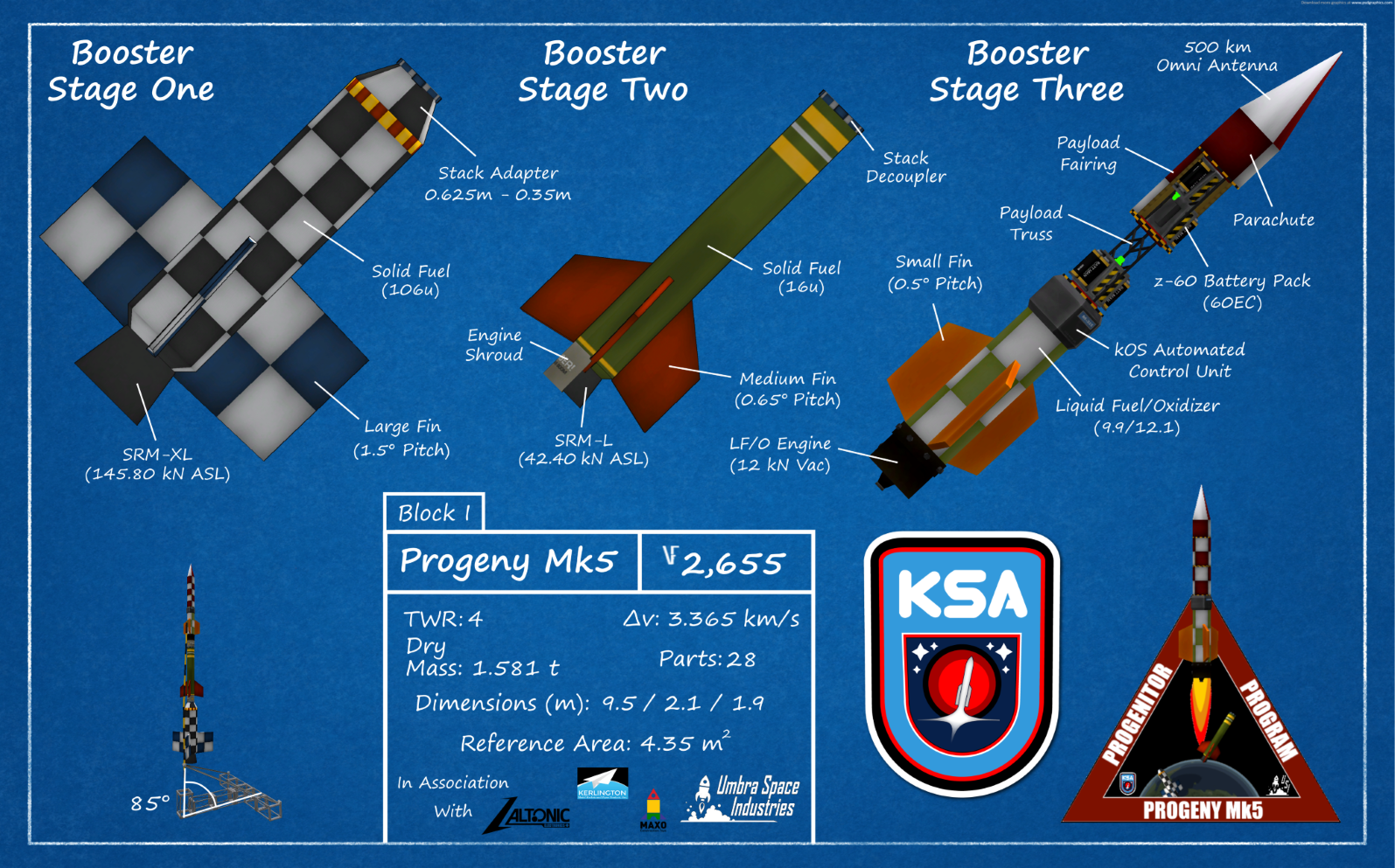 The newly-designated Block I design features two main improvements over the original:
The newly-designated Block I design features two main improvements over the original:
- Better Boosters. Umbra Space Industries has been working since early this year to improve their booster designs and finished testing some more powerful boosters two months ago, too late to make it onto the first run of Mk5s. The 0.625m booster now produces 145.8kN of thrust at sea level versus its original 131.25kN and the second-stage booster now pushes with 42.4kN of thrust at sea level versus its original 33.75kN. Both engines also have improved ISP ratings – the first stage will burn now for 20 seconds as opposed to 9.
- Lighter Fins. USI has also reworked the fins to be lighter yet still strong enough to withstand the pressures during powered ascent through the lower atmosphere. This has saved 110kg of mass and with the improved booster performance the Mk5 Block I has a total of 3.365km/s of deltaV compared to the original’s 2.198km/s
In addition, the launch base will be pitched back to 85° and the fins for the upper stages have had their pitch angles slightly reduced to account for the increase in thrust from the lower stages – the more energy that is put into spinning the rocket the less that it being used to push it upwards. The thrust at launch will still generate 4Gs, and the second-stage booster has been set to produce a TWR of 2 at 6km ASL. We also plan to run the third-stage engine at a TWR of 2 until dynamic pressure begins to decrease, after which the engine will throttle up to full over the next 5 seconds. As with the last Mk5 it will be fully automated and we will have some improvements ready to test with our flight control software.
So what exactly is up with the Block I designation? We’ve decided to go with the use of the term “block” to refer to a variation of a rocket design. In some cases, a higher block designation can simply mean a more powerful rocket, in other cases it could also mean the rocket serves a different purpose, or uses a different core piece of technology. For example a future orbital rocket could have its Block I designation refer to an un-kerbed vessel whereas Block II could lift crew. For the Mk5, which are all uncrewed, the Block II will refer to a more powerful rocket. Now that this Block I redesign is approved, engineers will be spending next week finalizing the Mk5 Block II design, which will incorporate elements from these design prototypes drawn up during the Mk4 phase. Stay tuned!







